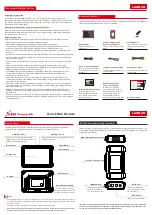
58
– Motor B:
ON
– Synchronized mode:
enabled
– Total therapy time:
0
– Special functions
disabled
LEVEL 3:
n
Reverse on load - motor A
(feature for patient safety)
In the
synchronized mode
, the carriage
automatically moves to the middle posi-
tion when the patient's resistance (load)
exceeds the set value.
In the
non-synchronized mode
, the car-
riage automatically moves in the opposite
direction when the patient's resistance
(load) exceeds the set value.
Adjustable levels for reverse on load fea-
ture: 1 - 25. At level 1, very low resistance
will cause the device to reverse; at level
25, a high resistance is required to initiate
the reversal.
Default setting: Level 25
n
Reverse on load - motor B
(feature for patient safety)
In the
synchronized mode
, the carriage
automatically moves to the middle posi-
tion when the patient's resistance (load)
exceeds the set value.
In the
non-synchronized mode
, the car-
riage automatically moves in the opposite
direction when the patient's resistance
(load) exceeds the set value.
Adjustable levels for reverse on load fea-
ture: 1 - 25. At level 1, very low resistance
will cause the device to reverse; at level
25, a high resistance is required to initiate
the reversal.
Default setting: Level 25
m
Caution!
Patient hazard –
The reverse-on-load feature is only a
safety measure in the event of cramps,
spasms, locked joints and similar condi-
tions. The manufacturer cannot be held
liable for misuse of this feature.
n
Motor A ON/OFF
To permit fully isolated movements, the
motors can individually be turned on and
off. Motor A performs dorsal extension
and plantar flexion movements motor B
performs eversion and inversion.
For an isolated eversion / inversion
movement, set motor A to the appropri-
ate position (dorsal extension / plantar
flexion), then turn the motor off.
In the normal operating mode, the display
will show the symbol for the disabled
dorsal / plantar movement
.
Default setting: motor A ON
n
Motor B ON/OFF
To permit fully isolated movements, the
motors can individually be turned on and
off. Motor A performs dorsal extension
and plantar flexion movements motor B
performs eversion and inversion.
For an isolated dorsal extension / plantar
flexion movement, set motor B to the ap-
propriate position (inversion / eversion),
then turn the motor off.
In the normal operating mode, the display
will show the symbol for the inversion /
eversion movement
disabled
.
Default setting: motor B ON
Note!
Please note that one motor (A or B)
must always be turned on.
Otherwise the display will show the
message:
LEVEL 4:
n
Transport setting
With this function, the device will move
to a position optimally suited for packing.
Select the function and press the START
button. The carriage moves to the trans-
port position. In the top left-hand corner
of the display you will see
(also
refer to chapter 6 Transport)
n
Synchronized/non-synchronized mode
Motors A and B can run in synchronized
or non-synchronized mode.
Summary of Contents for 80.00.035
Page 234: ...230 Notes ...
Page 237: ...VII Notes ...
















































